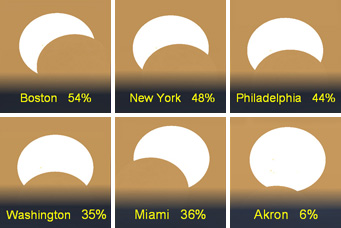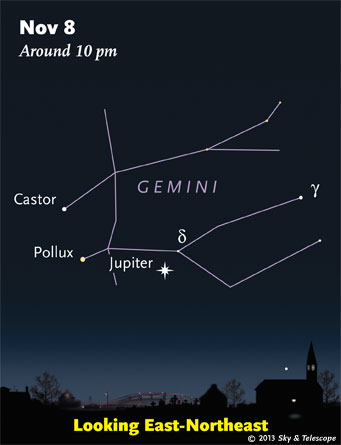Friday, November 1

Weather permitting, early risers along the Eastern Seaboard can see a partial solar eclipse at sunrise on November 3, 2013.
Sky & Telescope illustration / source: Stellarium
Saturday, November 2
Sunday, November 3
Monday, November 4

Fresh out of eclipsing the Sun when precisely new, the Moon waxes past Venus in twilight. (These scenes are drawn for the middle of North America. European observers: move each Moon symbol a quarter of the way toward the one for the previous date. The blue 10° scale is about the size of your fist held at arm's length. For clarity, the Moon is shown three times actual size.)
Sky & Telescope diagram
Tuesday, November 5
Wednesday, November 6
Thursday, November 7
Friday, November 8
Saturday, November 9
Want to become a better astronomer? Learn your way around the constellations. They're the key to locating everything fainter and deeper to hunt with binoculars or a telescope.
This is an outdoor nature hobby. For an easy-to-use constellation guide covering the whole evening sky, use the big monthly map in the center of each issue of Sky & Telescope, the essential guide to astronomy. Or download our free Getting Started in Astronomy booklet (which only has bimonthly maps).

The Pocket Sky Atlas plots 30,796 stars to magnitude 7.6 — which may sound like a lot, but that's less than one star in an entire telescopic field of view, on average. By comparison, Sky Atlas 2000.0 plots 81,312 stars to magnitude 8.5, typically one or two stars per telescopic field. Both atlases include many hundreds of deep-sky targets — galaxies, star clusters, and nebulae — to hunt among the stars.
Sky & Telescope
Once you get a telescope, to put it to good use you'll need a detailed, large-scale sky atlas (set of charts). The standards are the little Pocket Sky Atlas, which shows stars to magnitude 7.6; the larger and deeper Sky Atlas 2000.0 (stars to magnitude 8.5); and once you know your way around, the even larger Uranometria 2000.0 (stars to magnitude 9.75). And read how to use sky charts with a telescope.
You'll also want a good deep-sky guidebook, such as Sue French's Deep-Sky Wonders collection (which includes its own charts), Sky Atlas 2000.0 Companion by Strong and Sinnott, the bigger Night Sky Observer's Guide by Kepple and Sanner, or the beloved if dated Burnham's Celestial Handbook.
Can a computerized telescope replace charts? Not for beginners, I don't think, and not on mounts and tripods that are less than top-quality mechanically (able to point with better than 0.2° repeatability, which means heavy and expensive). As Terence Dickinson and Alan Dyer say in their invaluable Backyard Astronomer's Guide, "A full appreciation of the universe cannot come without developing the skills to find things in the sky and understanding how the sky works. This knowledge comes only by spending time under the stars with star maps in hand."
This Week's Planet Roundup

Jupiter is nearly stationary all week with respect to the surrounding stars of Gemini. Jupiter and Gemini come up into good view about a half hour earlier each week as the season proceeds.
Sky & Telescope
Mercury and Saturn are hidden in the glare of the Sun.
Venus (magnitude –4.5) shines brightly in the southwest during dusk. It sets nearly an hour after dark now. In a telescope, Venus has waned to appear a trace less than half-lit.
Mars (magnitude 1.5, in Leo) rises around 1 or 2 a.m. standard time. It's moving eastward against the background stars, pulling farther away down from Regulus. By dawn, Mars and Regulus are high in the south.
Comet ISON is below Mars, in the hind feet of Leo, before the first light of dawn. But it's still a faint telescopic target at about 9th magnitude. Use the finder chart for it in the November Sky & Telescope, page 50.
Jupiter (magnitude –2.4, in Gemini) rises in the east-northeast around 9 or 10 p.m. standard time and blazes high in the south before dawn. Left of it after it rises are Castor and Pollux. In a telescope Jupiter has grown to 41 arcseconds wide, as it heads toward its January 5th opposition.
Uranus (magnitude 5.7, in Pisces) and Neptune (magnitude 7.9, in Aquarius) are high in the southeast and south, respectively, in early evening. Finder charts for Uranus and Neptune. See also the October Sky & Telescope, page 50.
All descriptions that relate to your horizon — including the words up, down, right, and left — are written for the world's mid-northern latitudes. Descriptions that also depend on longitude (mainly Moon positions) are for North America. Eastern Daylight Time (EDT) equals Universal Time (also known as UT, UTC, or GMT) minus 4 hours. Eastern Standard Time (EST) is UT minus 5 hours.
Like This Week's Sky at a Glance? Watch our SkyWeek TV short, also playing on PBS.
To be sure to get the current Sky at a Glance, bookmark this URL:
http://SkyandTelescope.com/observing/ataglance?1=1
If pictures fail to load, refresh the page. If they still fail to load, change the 1 at the end of the URL to any other character and try again.
 0
0
Comments
You must be logged in to post a comment.